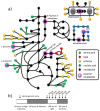Reconstruction and analysis of genome-scale metabolic model of a photosynthetic bacterium
- PMID: 21083885
- PMCID: PMC3009638
- DOI: 10.1186/1752-0509-4-156
Reconstruction and analysis of genome-scale metabolic model of a photosynthetic bacterium
Abstract
Background: Synechocystis sp. PCC6803 is a cyanobacterium considered as a candidate photo-biological production platform--an attractive cell factory capable of using CO2 and light as carbon and energy source, respectively. In order to enable efficient use of metabolic potential of Synechocystis sp. PCC6803, it is of importance to develop tools for uncovering stoichiometric and regulatory principles in the Synechocystis metabolic network.
Results: We report the most comprehensive metabolic model of Synechocystis sp. PCC6803 available, iSyn669, which includes 882 reactions, associated with 669 genes, and 790 metabolites. The model includes a detailed biomass equation which encompasses elementary building blocks that are needed for cell growth, as well as a detailed stoichiometric representation of photosynthesis. We demonstrate applicability of iSyn669 for stoichiometric analysis by simulating three physiologically relevant growth conditions of Synechocystis sp. PCC6803, and through in silico metabolic engineering simulations that allowed identification of a set of gene knock-out candidates towards enhanced succinate production. Gene essentiality and hydrogen production potential have also been assessed. Furthermore, iSyn669 was used as a transcriptomic data integration scaffold and thereby we found metabolic hot-spots around which gene regulation is dominant during light-shifting growth regimes.
Conclusions: iSyn669 provides a platform for facilitating the development of cyanobacteria as microbial cell factories.
Figures




Similar articles
-
Flux coupling and transcriptional regulation within the metabolic network of the photosynthetic bacterium Synechocystis sp. PCC6803.Biotechnol J. 2011 Mar;6(3):330-42. doi: 10.1002/biot.201000109. Epub 2011 Jan 11. Biotechnol J. 2011. PMID: 21226012
-
Reconstruction and verification of a genome-scale metabolic model for Synechocystis sp. PCC6803.Appl Microbiol Biotechnol. 2011 Oct;92(2):347-58. doi: 10.1007/s00253-011-3559-x. Epub 2011 Sep 1. Appl Microbiol Biotechnol. 2011. PMID: 21881889
-
The Transcriptional Landscape of the Photosynthetic Model Cyanobacterium Synechocystis sp. PCC6803.Sci Rep. 2016 Feb 29;6:22168. doi: 10.1038/srep22168. Sci Rep. 2016. PMID: 26923200 Free PMC article.
-
Synechocystis sp. PCC6803 metabolic models for the enhanced production of hydrogen.Crit Rev Biotechnol. 2015 Jun;35(2):184-98. doi: 10.3109/07388551.2013.829799. Epub 2013 Oct 3. Crit Rev Biotechnol. 2015. PMID: 24090244 Review.
-
Development of Synechocystis sp. PCC 6803 as a phototrophic cell factory.Mar Drugs. 2013 Aug 13;11(8):2894-916. doi: 10.3390/md11082894. Mar Drugs. 2013. PMID: 23945601 Free PMC article. Review.
Cited by
-
Unraveling bacterial stress responses: implications for next-generation antimicrobial solutions.World J Microbiol Biotechnol. 2024 Jul 29;40(9):285. doi: 10.1007/s11274-024-04090-z. World J Microbiol Biotechnol. 2024. PMID: 39073503 Free PMC article.
-
Genome-scale modeling of light-driven reductant partitioning and carbon fluxes in diazotrophic unicellular cyanobacterium Cyanothece sp. ATCC 51142.PLoS Comput Biol. 2012;8(4):e1002460. doi: 10.1371/journal.pcbi.1002460. Epub 2012 Apr 5. PLoS Comput Biol. 2012. PMID: 22529767 Free PMC article.
-
Advances in metabolic modeling of oleaginous microalgae.Biotechnol Biofuels. 2018 Sep 5;11:241. doi: 10.1186/s13068-018-1244-3. eCollection 2018. Biotechnol Biofuels. 2018. PMID: 30202436 Free PMC article. Review.
-
Multiscale metabolic modeling: dynamic flux balance analysis on a whole-plant scale.Plant Physiol. 2013 Oct;163(2):637-47. doi: 10.1104/pp.113.224006. Epub 2013 Aug 7. Plant Physiol. 2013. PMID: 23926077 Free PMC article.
-
Quantifying the effects of light intensity on bioproduction and maintenance energy during photosynthetic growth of Rhodobacter sphaeroides.Photosynth Res. 2015 Feb;123(2):167-82. doi: 10.1007/s11120-014-0061-1. Epub 2014 Nov 27. Photosynth Res. 2015. PMID: 25428581
References
-
- Schopf J. In: The ecology of cyanobacteria. Whitton B, Potts M, editor. Dordrecht: Kluwer Academic Publishers; 2000. The Fossil Record: Tracing the Roots of the Cyanobacterial Lineage; pp. 13–35.
Publication types
MeSH terms
LinkOut - more resources
Full Text Sources
Molecular Biology Databases

